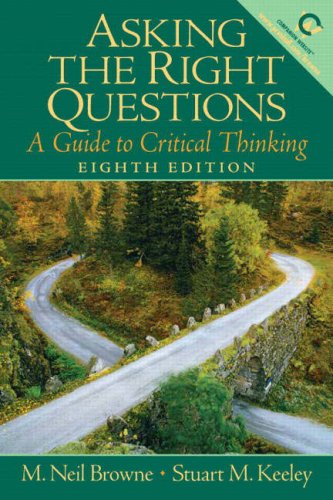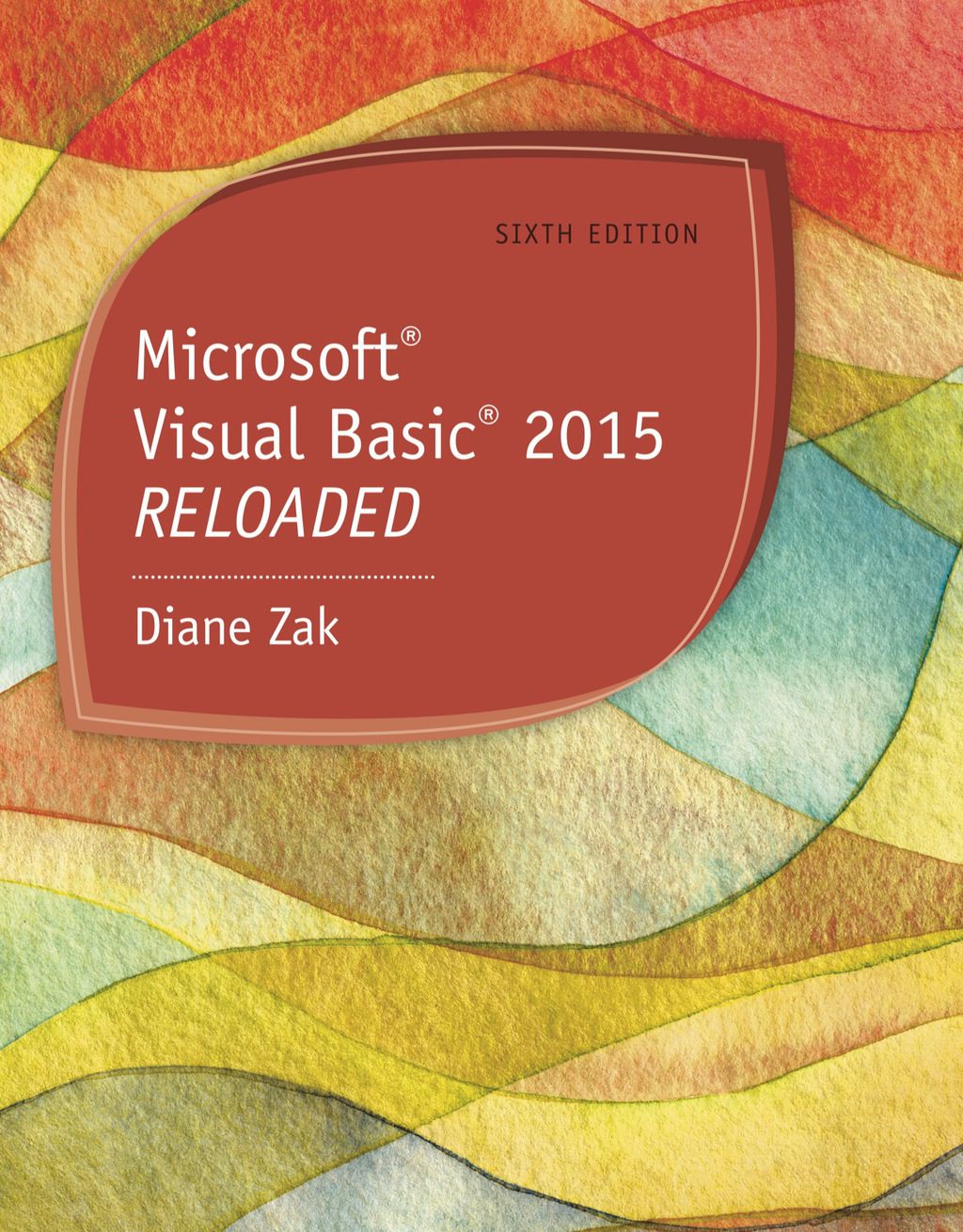M. Neil Browne, Stuart M. Keeley0132203049, 9780132203043
Table of contents :
Cover……Page 1
Copyright page……Page 4
Contents……Page 5
Preface……Page 10
Introduction……Page 15
Critical Thinking to the Rescue……Page 16
The Sponge and Panning for Gold: Alternative Thinking Styles……Page 17
An Example of the Panning-for-Gold Approach……Page 19
The Myth of the “Right Answer”……Page 21
Thinking and Feeling……Page 22
The Efficiency of Asking the Question, “Who Cares?”……Page 23
Weak-Sense and Strong-Sense Critical Thinking……Page 24
Trying Out New Answers……Page 25
The Importance of Practice……Page 26
The Right Questions……Page 27
2 What Are the Issue and the Conclusion?……Page 29
Kinds of Issues……Page 30
Searching for the Issue……Page 31
Searching for the Author’s or Speaker’s Conclusion……Page 32
1. Ask what the issue is…….Page 33
4. Remember what a conclusion is not…….Page 34
Critical Thinking and Your Own Writing and Speaking……Page 35
Practice Exercises……Page 36
3 What Are the Reasons?……Page 39
Reasons + Conclusion = Argument……Page 40
Initiating the Questioning Process……Page 41
Kinds of Reasons……Page 43
Clues for Identifying and Organizing the Reasoning of a Passage……Page 45
“Fresh” Reasons and Your Growth……Page 46
Practice Exercises……Page 47
4 What Words or Phrases Are Ambiguous?……Page 51
The Confusing Flexibility of Words……Page 52
Locating Key Terms and Phrases……Page 53
Checking for Ambiguity……Page 54
Determining Ambiguity……Page 55
Context and Ambiguity……Page 57
Ambiguity, Definitions, and the Dictionary……Page 58
Ambiguity and Loaded Language……Page 60
Ambiguity and Your Own Writing and Speaking……Page 62
Practice Exercises……Page 63
5 What Are the Value Conflicts and Assumptions?……Page 67
General Guide for Identifying Assumptions……Page 69
Value Conflicts and Assumptions……Page 70
Discovering Values……Page 71
From Values to Value Assumptions……Page 72
Typical Value Conflicts……Page 74
Consequences as Clues to Value Assumptions……Page 75
Clues for Identifying Value Assumptions……Page 77
Avoiding a Typical Difficulty When Identifying Value Assumptions……Page 78
Finding Value Assumptions on Your Own……Page 79
Values and Relativism……Page 81
Practice Exercises……Page 82
6 What Are the Descriptive Assumptions?……Page 85
Illustrating Descriptive Assumptions……Page 86
Look for ideas that support reasons…….Page 88
Recognize the potential existence of other means of attaining the advantages referred to in the reasons…….Page 89
Applying the Clues……Page 90
Assumptions and Your Own Writing and Speaking……Page 92
Practice Exercises……Page 93
7 Are There Any Fallacies in the Reasoning?……Page 97
A Questioning Approach to Finding Reasoning Fallacies……Page 99
Evaluating Assumptions as a Starting Point……Page 100
Discovering Other Common Reasoning Fallacies……Page 102
Looking for Diversions……Page 108
Sleight of Hand: Begging the Question……Page 110
Summary of Reasoning Errors……Page 111
Clues for Locating and Assessing Fallacies in Reasoning……Page 112
Practice Exercises……Page 113
8 How Good is the Evidence: Intuition, Personal Experience, Testimonials, and Appeals to Authority?……Page 117
The Need for Evidence……Page 118
Locating Factual Claims……Page 119
Sources of Evidence……Page 120
Intuition as Evidence……Page 121
Dangers of Appealing to Personal Experience as Evidence……Page 122
Personal Testimonials as Evidence……Page 123
Appeals to Authority as Evidence……Page 124
Clues for Evaluating the Evidence……Page 127
Practice Exercises……Page 128
Personal Observation……Page 131
Research Studies as Evidence……Page 132
Problems with Research Findings……Page 133
Clues for Evaluating Research Studies……Page 136
Generalizing from the Research Sample……Page 137
Biased Surveys and Questionnaires……Page 138
Critical Evaluation of a Research-Based Argument……Page 140
Case Examples as Evidence……Page 142
Analogies as Evidence……Page 143
Identifying and Comprehending Analogies……Page 144
Evaluating Analogies……Page 145
Summary……Page 147
Practice Exercises……Page 148
10 Are There Rival Causes?……Page 151
When to Look for Rival Causes……Page 152
The Pervasiveness of Rival Causes……Page 153
Detecting Rival Causes……Page 155
The Cause or A Cause……Page 156
Rival Causes and Scientific Research……Page 157
Rival Causes for Differences Between Groups……Page 158
Confusing Causation with Association……Page 160
Confusing “After this” with “Because of this”……Page 161
Explaining Individual Events or Acts……Page 163
Summary……Page 164
Practice Exercises……Page 165
11 Are the Statistics Deceptive?……Page 169
Confusing Averages……Page 170
Concluding One Thing, Proving Another……Page 172
Deceiving by Omitting Information……Page 173
Risk Statistics and Omitted Information……Page 175
Clues for Assessing Statistics……Page 176
Practice Exercises……Page 177
12 What Significant Information Is Omitted?……Page 181
The Certainty of Incomplete Reasoning……Page 182
Clues for Finding Common Kinds of Significant Information……Page 184
The Importance of the Negative View……Page 188
Omitted Information That Remains Missing……Page 189
Practice Exercises……Page 190
13 What Reasonable Conclusions Are Possible?……Page 195
DichotomousThinking: Impediment to Considering Multiple Conclusions……Page 196
Two Sides or Many?……Page 197
Searching for Multiple Conclusions……Page 199
Productivity of If-Clauses……Page 200
Alternative Solutions as Conclusions……Page 201
All Conclusions Are Not Created Equal……Page 202
Summary……Page 203
Practice Exercises……Page 204
Question Checklist for Critical Thinking……Page 207
Asking the Right Questions: A Comprehensive Example……Page 208
What Are the Reasons?……Page 210
What Words or Phrases Are Ambiguous?……Page 211
What Are the Descriptive Assumptions?……Page 212
Are There Any Fallacies in the Reasoning?……Page 213
How Good Is the Evidence?……Page 214
Are the Statistics Deceptive?……Page 215
What Significant Information Is Omitted?……Page 216
What Reasonable Conclusions Are Possible?……Page 217
The Tone of Your Critical Thinking……Page 219
Strategies for Effective Critical Thinking……Page 220
Index……Page 223







Reviews
There are no reviews yet.